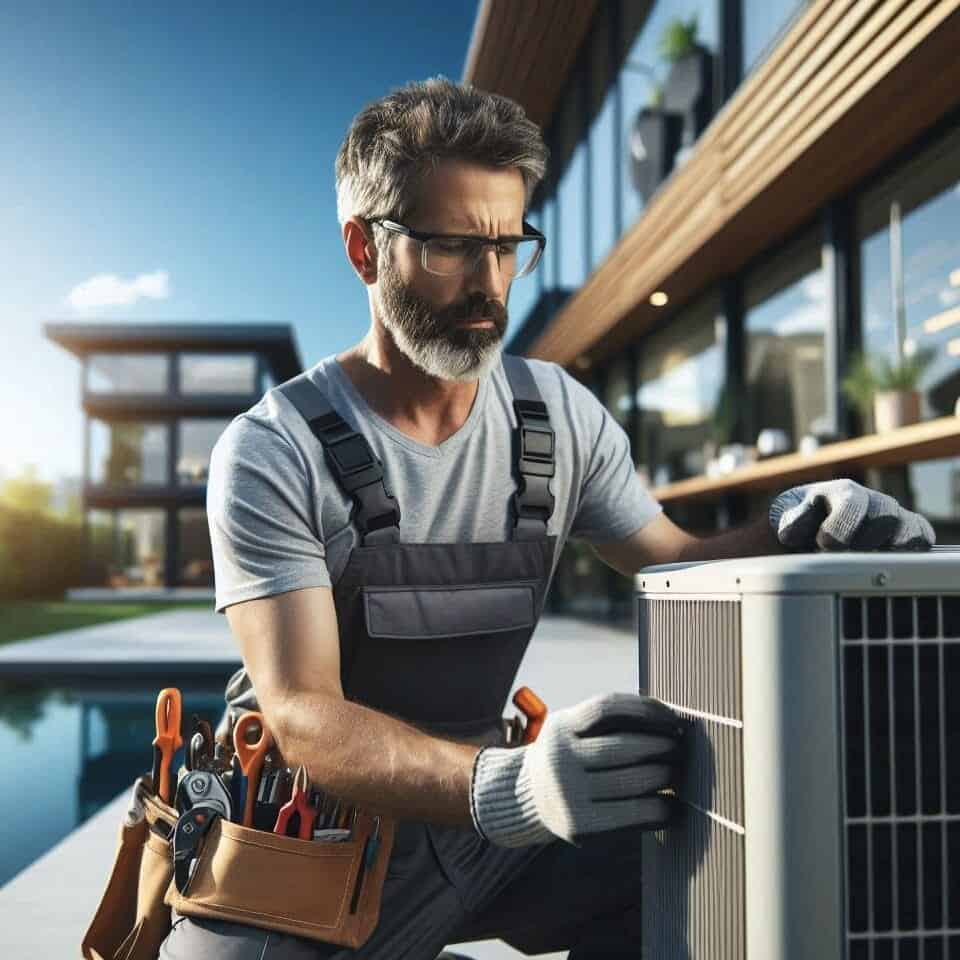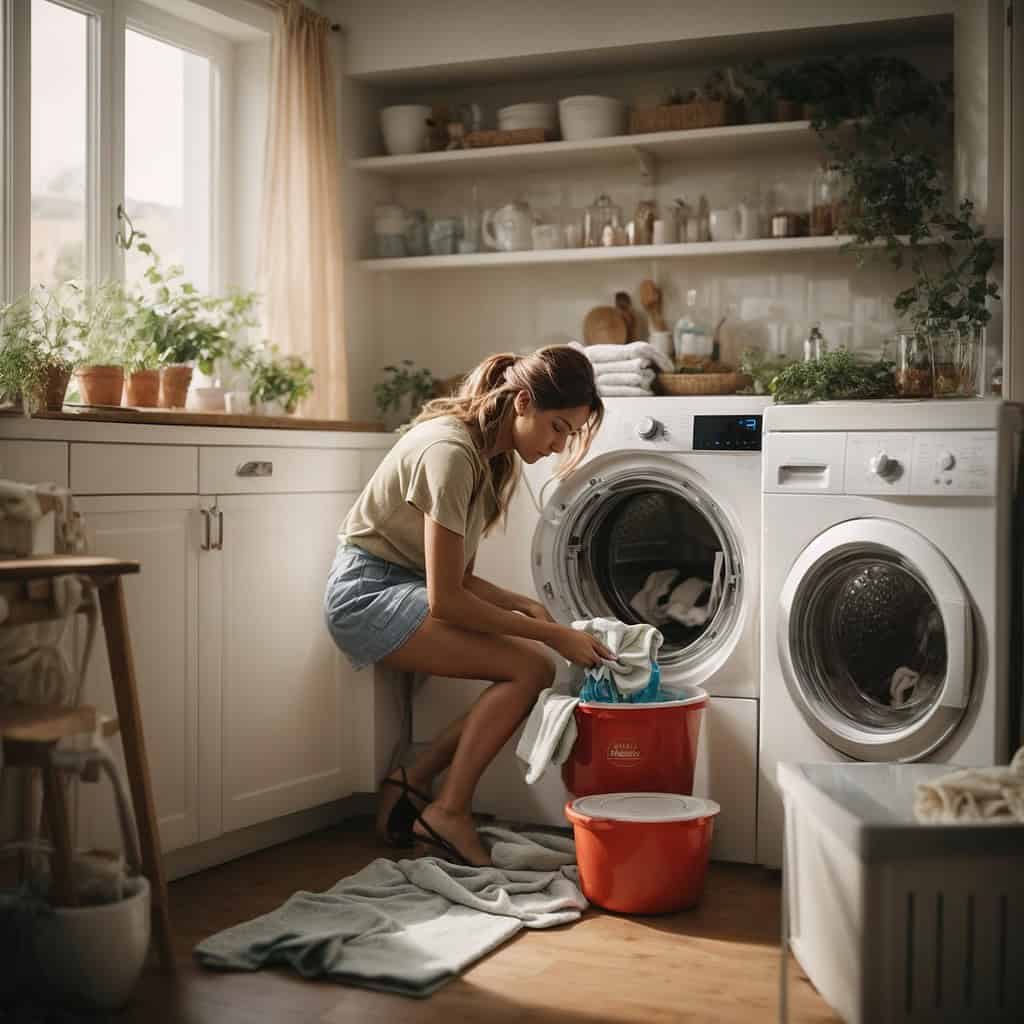
In my previous life as a furnace repair specialist, I’ve encountered numerous cases where homeowners face the inconvenience of a non-responsive heating system. A malfunctioning furnace can leave you shivering in the winter chill. Before you reach for the phone to call for professional help, let’s go through some troubleshooting tips that may get your furnace up and running again.
In this guide, I’ll walk you through eight steps to diagnose and resolve the issue, from simple thermostat checks to potential maintenance tasks.
- Understanding the Importance of a Functioning Furnace
- Check the Thermostat Settings
- Inspect the Gas Supply
- Assess Power Supply Issues
- Replace or Clean Air Filters
- Check for Blockages in the Ductwork
- Troubleshoot Ignition Problems
- Ensure Furnace Door is Secured
- Seek Professional HVAC Help
- Summing Up
- More Useful Reads
Understanding the Importance of a Functioning Furnace
A functioning furnace is essential for several important reasons. Firstly, it ensures that your home remains warm and comfortable during the colder months, creating a cozy living environment. This warmth is not just about comfort; it also plays a crucial role in maintaining health by preventing cold-related issues such as hypothermia and respiratory problems.
When a well-maintained and operational furnace runs efficiently, it helps in saving energy costs. This efficiency will reduce your utility bills and also minimize wear and tear on the system, prolonging its lifespan and ensuring it operates smoothly when you need it the most.
A malfunctioning furnace can be daunting, but by following these practical steps, you might save yourself time, money, and a chilly night.
In this post, we will provide 8 troubleshooting tips to isolate the issue before calling for professional help.
Check the Thermostat Settings
Starting with the Basics: Ensuring the Right Settings
The thermostat serves as the command center for your furnace, so it’s essential to verify that it’s correctly configured for heating mode.
Here’s what to check:
- Set to “Heat”: Ensure your thermostat is set to “heat” and not “cool” or “off.” This might sound obvious, but it’s a common oversight.
- Check for Dead Batteries: Some thermostats require batteries to function. If the display is blank or unresponsive, replacing the batteries might solve the issue.
- Level and Clear: The thermostat should be level and free from obstructions. Dust or debris can interfere with its sensors, leading to inaccurate readings.
If your thermostat isn’t functioning correctly, it could be a simple fix like changing batteries or adjusting settings.
Ensuring these basics can often resolve common thermostat issues and get your furnace back on track. However, if you’re dealing with a persistent problem, there are additional steps we can explore in this guide.
Inspect the Gas Supply
Making Sure There’s Fuel for the Fire
Does your furnace need enough gas to light up and create heat? If you notice your furnace isn’t heating up, it’s worth checking if the gas supply is intact. Begin by ensuring that the gas valve leading to the furnace is open. If it’s closed, simply turning it on should resolve the issue.
Remember to check the pilot light too —if it’s out, simply relighting it per your furnace’s instructions might suffice. However, if you smell gas or suspect a gas leak, it’s important to contact a professional immediately for assistance. Safety should always be prioritized in such situations.
Let’s examine this aspect of your heating system.
Verifying If the Gas Valve is Open
Locate the gas valve on your furnace. Ensure it is in the “on” position, which usually aligns with the pipe. If it’s in the “off” position, turn it to allow gas flow. If the valve was already on, try turning it off and then back on again. Sometimes, a slight adjustment can help restore gas flow. If you’re unsure about the position of the valve or any other step in this process, it’s best to consult your furnace’s manual or contact a professional.
Checking for any signs of gas leaks or issues with the gas line connections
Perform a visual inspection of the gas lines leading to your furnace. Look for any signs of wear, damage, or leaks. A hissing sound or the smell of gas can indicate a leak.
If you suspect a gas leak, immediate action must be taken.
Turn off the gas supply to your furnace, open windows and doors to ventilate the area, and evacuate the premises.
Contact your gas company or a licensed professional for assistance. Gas leaks can be highly dangerous and should never be ignored or handled by untrained individuals. It’s always better to err on the side of caution when it comes to safety.
Ensuring an uninterrupted fuel supply not only guarantees your furnace operates efficiently but also keeps you safe from potential hazards.
Assess Power Supply Issues
Ensuring the Furnace Gets the Electricity It Needs
 Without a stable power source, your furnace won’t be able to function properly. In addition to checking the gas supply, it’s important to address any power supply issues that could be affecting your furnace. Start by ensuring that the circuit breaker for your furnace is in the “on” position.
Without a stable power source, your furnace won’t be able to function properly. In addition to checking the gas supply, it’s important to address any power supply issues that could be affecting your furnace. Start by ensuring that the circuit breaker for your furnace is in the “on” position.
If it has tripped, reset it and monitor if it trips again. If it does, it may indicate a deeper electrical issue that requires professional attention.
Also, inspect the power cord for any damage or loose connections. If you notice any issues, contact an electrician to address them promptly and prevent further problems.
Let’s check for any potential power supply problems:
- Ensure the Power Switch on the Furnace is Turned On: Many furnaces have a dedicated power switch located nearby. Make sure this switch is in the “on” position.
- Check for Tripped Breakers in the Electrical Panel: Head over to your electrical panel and look for any tripped breakers related to the furnace circuit. Resetting a tripped breaker might resolve the issue.
A reliable power supply is crucial for your furnace’s operation. Addressing these basic checks can often save you from unnecessary frustration and chilly nights.
If the issue persists, it’s best to call a professional HVAC technician to diagnose and fix the problem. They have the expertise and tools to safely handle electrical issues and ensure your furnace is running efficiently.
Inspecting and addressing power supply issues can go a long way in maintaining a properly functioning furnace. When you take these simple steps, you can potentially avoid costly repairs and ensure a comfortable and warm home during the colder months.
Replace or Clean Air Filters
Maintaining Clean Air Flow
A dirty air filter can restrict airflow and cause your furnace to overheat or shut down as a safety measure. Addressing this common maintenance task is important for maintaining your furnace’s efficiency.
Not only does a clean air filter ensure proper airflow, but it also helps improve indoor air quality. Depending on the type of filter you have, it’s recommended to replace or clean it every 1-3 months. This simple task can often resolve performance issues and save you from costly repairs down the line.
How a Clogged Air Filter Affects Furnace Efficiency
When the air filter becomes clogged, it obstructs the airflow, making your furnace work harder to circulate air. This can lead to:
- Reduced heating efficiency
- Increased energy consumption
- Potential overheating issues
Steps to Locate, Clean, or Replace Your Furnace Air Filter
- Locate the Air Filter: Typically found in the return air duct or blower compartment.
- Inspect the Filter: Check for dust and debris accumulation.
- Clean or Replace: If reusable, clean according to the manufacturer’s instructions; otherwise, replace with a new filter.
Regular maintenance of your air filter not only improves your furnace’s performance but also enhances indoor air quality. By regularly cleaning or replacing your air filter, you can prevent potential issues such as increased energy consumption and overheating.
To maintain your filter’s efficiency, locate it in the return air duct or blower compartment. Inspect it for dust and debris accumulation and clean or replace it accordingly. Not only will this simple task improve your furnace’s performance, but it will also contribute to better indoor air quality.
Check for Blockages in the Ductwork
Ensuring smooth circulation of warm air throughout your home is essential for maintaining a comfortable environment. Blocked ductwork can disrupt this flow, leaving certain rooms cold and uninviting.
To check for blockages in the ductwork, start by visually inspecting the exposed sections for any visible obstructions.
How to Identify Potential Blockages in the Ducts
If some areas of your home aren’t heating properly, it’s time to inspect the ductwork for blockages. Here’s how to identify potential issues:
- Visual Inspection: Look for any visible obstructions like dust, debris, or even small objects that may have entered the ducts.
- Listen for Airflow: Hold your hand near vents while the furnace is running. If you notice weak airflow in specific areas, this might indicate a blockage.
If you notice any debris or objects blocking the airflow, remove them carefully. For hard-to-reach areas, it’s best to seek professional assistance from an HVAC technician who can use specialized tools to thoroughly clean and clear the ducts. By addressing potential blockages, you can maximize the efficiency of your furnace and ensure consistent warmth throughout your home.
Why Proper Airflow Matters
Proper airflow is crucial for efficient heating performance:
- Energy Efficiency: Clear ducts ensure that your furnace doesn’t overwork, thus saving on energy costs.
- System Longevity: Unobstructed ducts reduce strain on your furnace, extending its lifespan.
For more detailed home maintenance tips, you may find our article on how to fix a stuck window helpful. It offers effective troubleshooting tips that can be applied to various scenarios involving windows that won’t budge or are stuck.
Keep these points in mind as you continue troubleshooting your furnace issues.
Troubleshoot Ignition Problems
Igniting the Flame: Examining the Ignition System for Issues
The ignition sensor or assembly is essential for initiating the combustion process in your furnace. Addressing issues with this component can often resolve ignition problems. Common issues include a dirty or faulty sensor, a misaligned ignition assembly, or a worn-out ignitor.
Start by inspecting the sensor for any dirt or debris. If present, clean it gently with a soft cloth.
Check the alignment of the ignition assembly and ensure it is properly positioned. If the ignitor is damaged or worn out, it may need to be replaced. You can consult your furnace’s manual or contact an HVAC professional for guidance on proper maintenance and troubleshooting of the ignition system.
Role of the Ignition Sensor in Furnace Operation
- The ignition sensor detects whether the burner has successfully ignited.
- It sends a signal to the control board, confirming combustion.
- If the sensor fails, the furnace may shut down as a safety measure.
How to Clean the Ignition Sensor Effectively
- Turn off Power and Gas Supply: Ensure safety by cutting off both power and gas.
- Locate the Ignition Sensor: Typically found near the burners.
- Remove and Clean: Gently unscrew and clean using fine sandpaper or a brush.
Signs That May Indicate a Faulty Ignition Sensor
- Frequent shutdowns after a brief operation.
- No response when trying to ignite.
- Error codes on your furnace display panel.
If cleaning doesn’t resolve the issue, a faulty ignition sensor may need replacement.
Once you fix these potential ignition problems, you can keep your furnace running smoothly and efficiently.
Ensure Furnace Door is Secured
Most modern furnaces have safety features in place to prevent them from operating if the access panel or door isn’t securely closed. This is an important safety precaution to prevent potential dangers. Always make sure that the furnace door is properly secured after any maintenance or troubleshooting. If the door isn’t closed tightly, it may trigger a safety switch that shuts off the furnace. This can cause inconvenience and potentially compromise your comfort during colder months.
So, be mindful of this simple yet crucial step to ensure your furnace operates smoothly.
What to Check:
- Secure Closure: Double-check that the furnace door is tightly shut and properly latched. If the door isn’t fitted snugly, it can activate the safety switch and prevent the furnace from turning on.
- Safety Mechanisms: These mechanisms automatically disable the furnace when the door is open, ensuring that no harmful gases escape and all internal parts are safeguarded.
Sometimes, a seemingly small issue like an improperly closed furnace door can be the main reason behind your heating problems. When dealing with this, make sure all panels are correctly aligned and secured.
Taking the time to ensure that your furnace door is secured can save you from unnecessary service calls and keep your heating system running smoothly.
Seek Professional HVAC Help

Knowing When to Call in the Experts
While these troubleshooting steps can resolve many common issues preventing a furnace from turning on, certain problems are best left to trained HVAC professionals. If you’ve checked the thermostat settings, gas supply, power issues, air filters, ductwork, ignition system, and furnace door without success, it’s time to call in an expert.
Benefits of Regular Maintenance
Regular maintenance by a licensed HVAC technician ensures your furnace operates efficiently and has a longer lifespan. Routine check-ups help identify potential issues before they become major problems. This can save you from costly repairs down the line. Additionally, a well-maintained furnace can also help lower your energy bills, as it operates more efficiently. So, while troubleshooting small issues on your own can be helpful, don’t hesitate to seek professional assistance when needed.
Recommended Maintenance Schedule
It’s advisable to schedule professional maintenance at least once a year. A well-maintained furnace is less likely to break down during the cold months when you need it most. This can save you from costly repairs down the line. Additionally, a well-maintained furnace can also help lower your energy bills, as it operates more efficiently. So, while troubleshooting small issues on your own can be helpful, don’t hesitate to seek professional assistance when needed.
What to Expect During a Routine Maintenance Visit
During a maintenance visit, an HVAC technician will:
- Inspect and clean the furnace components
- Check for any wear and tear
- Test the system’s efficiency
- Ensure all safety features are functioning correctly
This proactive approach can save you from costly repairs and keep your home warm and safe.
Summing Up
In this comprehensive guide, we’ve explored 8 essential steps to take when you encounter the frustrating problem of a furnace that won’t turn on. Remember to always prioritize your safety and, if needed, don’t hesitate to seek assistance from a qualified HVAC technician.
Once you understand the basic components and functioning of your heating system, you can troubleshoot minor issues with confidence and potentially avoid costly repairs. However, should you find yourself facing more complex or persistent problems, it’s best to leave the job in the hands of professionals who have the necessary expertise and equipment.
Prioritize regular maintenance and follow a diligent care routine. This proactive approach will help maintain your home’s warmth and comfort, especially during those chilly winter months.
More Useful Reads
- Solved! This Is How to Fix a Furnace That’s Not Turning On – https://www.bobvila.com/articles/furnace-not-turning-on/
- 6 Things to Try When Your Furnace Won’t Turn On – https://larryandsons.com/blog/furnace-wont-turn-heres/
- Why My Furnace Won’t Turn On? How to Fix? [With Pictures] – https://www.supertechhvac.com/furnace-wont-turn-on/
- Jarboe’s Heating, Cooling & Plumbing – https://jarboes.com/knowledge-center/steps-to-take-if-your-furnace-wont-turn-on/
- Furnace Will Not Turn On With Thermostat: What To Do – Lawes Company – https://www.lawescompany.com/furnace-will-not-turn-on-with-thermostat/
- Thomas & Galbraith Heating, Cooling & Plumbing – Cincinnati & Dayton – https://thomasgalbraith.com/knowledge-center/what-to-do-when-your-furnace-doesnt-turn-on/
- 6 Reasons Why My Furnace Won’t Turn On & Troubleshooting Tips | Alpha Mechanical – https://alphamechanicals.com/blog/6-reasons-why-wont-furnace-turn-on/
- How to Reboot a Furnace: 3 Easy Steps to Restart Your Furnace | Crawford – https://crawford-services.com/blog/how-to-reboot-a-furnace-3-easy-steps-to-restart-your-furnace/
- Furnace Won’t Turn On? Try These Troubleshooting Tips – https://www.hoffmannbros.com/heating/furnace/troubleshooting
- Gas Furnace Not Working? Here’s How To Fix It – https://livefreehc.com/blog/gas-furnace-not-working/
- Furnace Exhaust Vent Blockage – https://www.eheatcool.com/info/hvac-problems/furnace-exhaust-vent-blockage/
- What Happens If the Furnace Exhaust Flue Is Blocked? – https://gobvs.com/furnace-exhaust-blocked/
- Frozen Condensate Line: Recognizing, Preventing & Fixing It | Broadley’s Plumbing, Heating & Air Conditioning – https://broadleys.net/frozen-codensate-line-ocean-city-nj/
- Cleaning Your HVAC Condensate Drain Line: Best Practices – Quality Heating Cooling Plumbing & Electric – https://quality-hc.com/blog/hvac-condensate-drain/
- Simple Steps to Test Your Home HVAC Ducts for Leaks – https://sanbornsac.com/test-hvac-ducts-for-leaks/
- When the Outside AC Unit’s Not Running But the Inside Is, Try This – https://comfortbyjansen.com/outside-ac-unit-not-running-but-inside-is/
- American Residential Services LLC – https://www.ars.com/blog/furnace-not-igniting
- 8 Things to Do When Your Furnace Ignitor Isn’t Igniting | Academy Air – https://www.academyair.com/8-things-to-do-when-your-furnace-ignitor-isnt-igniting/
- How To Fix a Furnace That’s Not Turning On (2024 Guide) – https://www.thisoldhouse.com/heating-cooling/reviews/furnace-not-turning-on
- Reasons For Your Furnace Won’t Turn On? | LG Home Comfort – https://lghomecomfort.ca/blog/reasons-and-solutions-why-your-furnace-wont-turn-on/

Dave Johnson is a mechanical engineer with over two decades of experience in the semiconductor industry. He’s known for his exceptional ability to fix almost any mechanical and electronic device, from leaking faucets to lawnmowers – he is definitely your go-to neighbor for household maintenance issues. When he’s not elbow-deep in his garage doing household repairs, you’ll find him sharing his expertise on fixing everyday maintenance challenges on this site.


